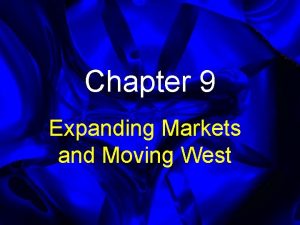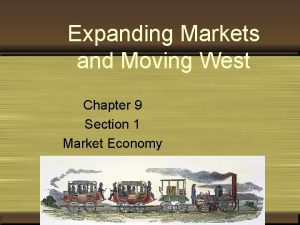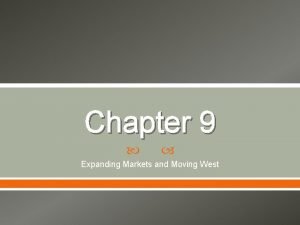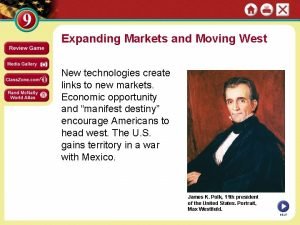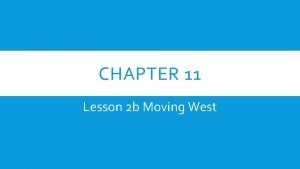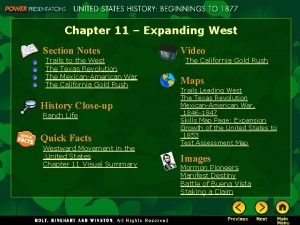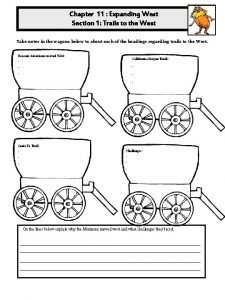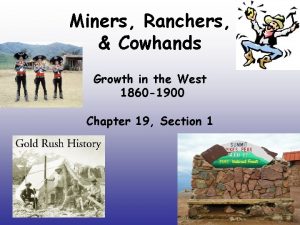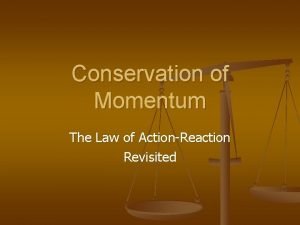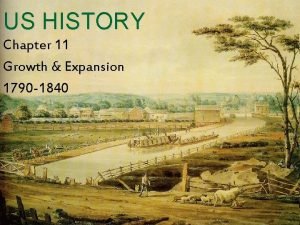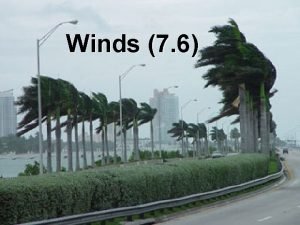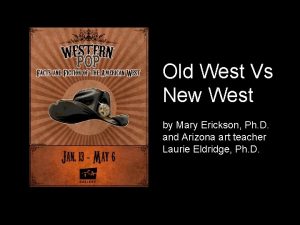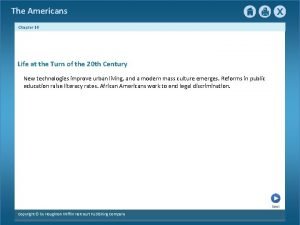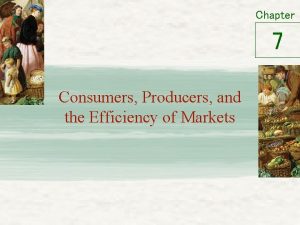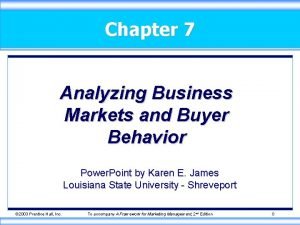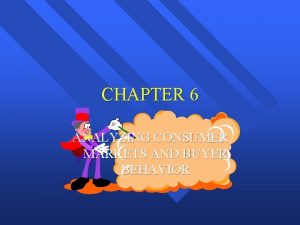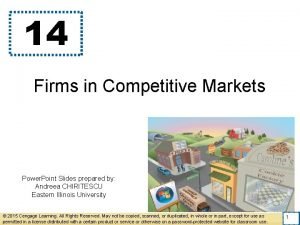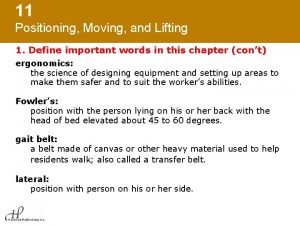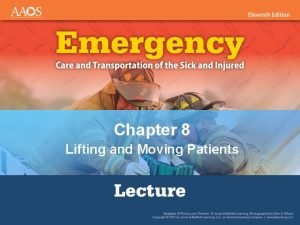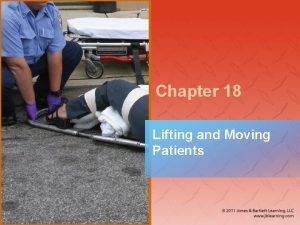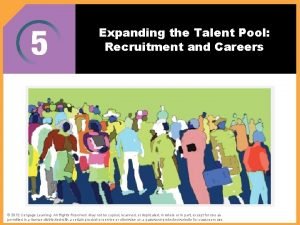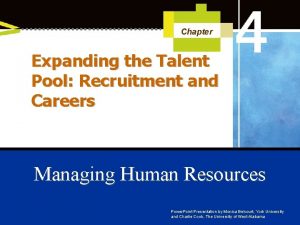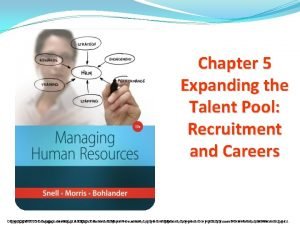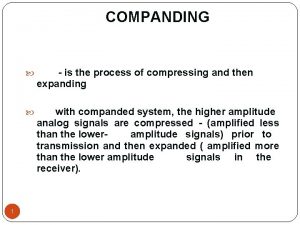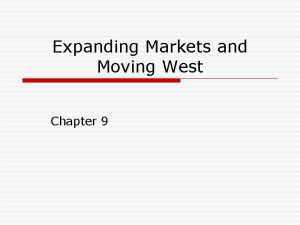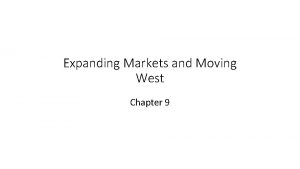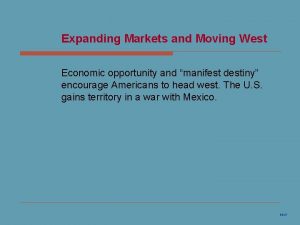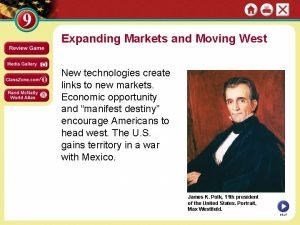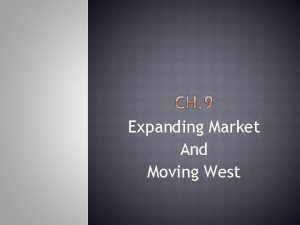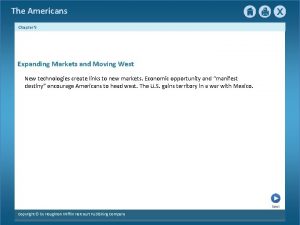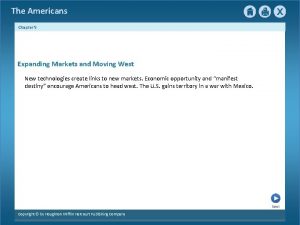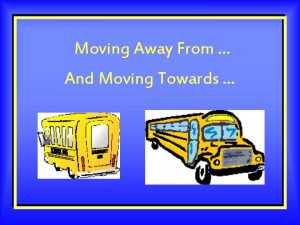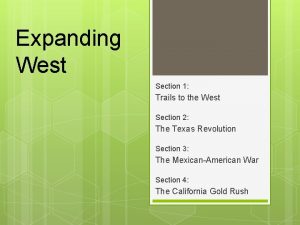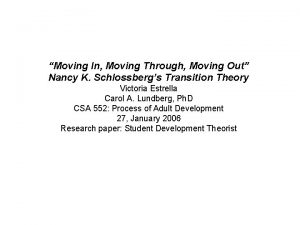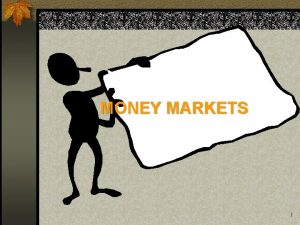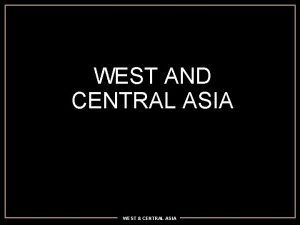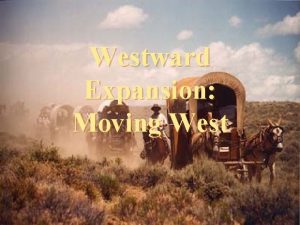Chapter 9 Expanding Markets and Moving West The













































































- Slides: 77

Chapter 9 Expanding Markets and Moving West

The Market Revolution 6/5/2021 • Technological changes created greater interaction and more economic diversity among the regions of the nation. • In 1837 painter and scientist Samuel F. B. Morse, and Leonard Gale, built an electromagnetic telegraph. • Congress granted Morse $30, 000 to build a 40 -mile telegraph line between Baltimore and Washington, D. C. 2

U. S. Markets Expand • In the early 19 th century workers produced their own goods or traded with neighbors to meet almost all their needs. • By the midcentury, however, the U. S. had become industrialized especially in the Northeast, where the rise of textile mills and factory system changed the lives of workers and consumers. • Farmers began to shift from self-sufficiency to specialization raising one or two cash crops that they could sell at home or abroad. • These developments led to a market revolution which people bought and sold goods rather than making them for their own use. 3

• The market revolution created a striking change in the U. S. economy and in the daily lives of Americans. • In the 1840 s the national economy grew more than it had in the previous 40 years. • One entrepreneur who developed an industry still vital today was Charles Goodyear. • Goodyear took a big risk that paid off for the American public but left him in debt. • Goodyear developed vulcanized rubber instead of India rubber, the new product didn’t freeze in the cold or melt in hot weather. 6/5/2021 4

• The quickening pace of U. S. growth depended on capitalism, the economic system in which private businesses and individuals control the means of production such as factories, machines, and land. • Investors called entrepreneurs risked their own money in hopes of making a profit. • The rise of capitalism led to investors willing to risk their own money in new industries standing to make huge profits. 6/5/2021 5

• A natural place for growth of industrialization was in the producing `` clothing, a process greatly added by the inventions of the sew machine. • Patented by Elias Howe in 1846, the sewing machine found its first use in shoe factories. • Homemakers appreciated I. M. Singer’s addition of the foot treadle, which drastically reduced the time to sew garments. 6/5/2021 6

• While entrepreneurial activity boosted America’s industrial output, American agricultural continued to flourish. • To meet these demands, the American farmers began to use mechanized farm equipment produced in factories. • Farmers, therefore, made significant contributions to the American industrial machine and became important contributions to the American industry. Why is this so important? 6/5/2021 7

• Manufactured items grew less expensive as technology advances lowered expenses. • What was the impact of the market revolution on potential customers? • The cost of consumer goods dropped, so more workers could become consumers. • The new inventions, many developed in the United States, contributed immensely to changes in American life. 6/5/2021 8

• Some inventions made life more enjoyable. • Other inventions fueled the economic revolution and transformed manufacturing, transportation and communication. • Businesses used the telegraph to transmit orders and relay up-to-date information on prices and sales. • Railroads employed the telegraph to keep trains moving regularly and to warn engineers of safety hazards. 6/5/2021 9

Impact of Transportation • Better and faster transportation became essential to the expansion of agricultural and industry. • Farmers and manufacturers alike sought more direct ways to ship their goods to market. • Water transportation was important in moving heavy machinery and raw materials like lead and copper. 6/5/2021 10

• The Erie Canal was the nation’s first major canal, and it was used heavily. • The Erie Canal success led to dozens of other canal projects. 6/5/2021 11

Emergence of Railroads • The heyday of the canals lasted only until the 1860 s, due to the rapid emergence of railroads. • Shipping by rail cost significantly more in the 1840 s than did shipping by canal, railroads offered the advantage of speed. • In addition, trains could operate in the winter, and they brought food to the people who lived inland. • By the 1840 s, steam engines pulled freight at ten miles and hour more than four times faster than canal boats. 6/5/2021 12

• Peter Cooper was an inventor, manufacturer, and philanthropist from New York City who built the Tom Thumb locomotive and founded The Cooper Union for the Advancement of Science and Art in New York City. • The Tom Thumb was designed and built by Peter Cooper in 1830. • The Tom Thumb was the first American-built steam locomotive to be operated on a commoncarrier railroad. • Passengers thrilled at the heart-pumping sensation of traveling at then un-heard speed of 18 mph. 6/5/2021 13

6/5/2021 14

• Peter Cooper also obtained the very first American patent for the manufacture of gelatin (1845). • In 1895, Pearl B. Wait, a cough syrup manufacturer, bought the patent from Peter Cooper and turned Cooper's gelatin dessert into a prepackaged commercial product, which his wife, May David Wait, renamed "Jell-O. ” 6/5/2021 15

New Market Link Regions • By the 1840, improved transportation and communication made America’s regions interdependent. • The National Road, whose construction began in 1811, had also opened up western travel. • The National Road was a federal project in early America designed to address a problem how to get the people westward to the new tracts of land. • The biggest problem with most roads 200 years ago was that wagon wheels created ruts, and even the smoothest dirt roads could be rendered nearly impassable. • In the early 1800 s a Scottish engineer, John Loudon Mac. Adam, had pioneered a method of building roads with broken stones, and roads of this type were thus named “macadam” roads. 6/5/2021 16

6/5/2021 17

• Growing links between American’s regions contributed to the development of regional specialties. • The South exported cotton to England as well as New England. • The West’s grain and livestock fed the factory workers in eastern cities and Europe. • The East manufactured textiles and machinery. 6/5/2021 18

Southern Agricultural • • • Most of the South remained what? Agricultural What crops did the South rely on for profits? Cotton, tobacco, rice and indigo. Why wasn’t the South industrialized? Didn’t want the filthy factories, overcrowding , lack of capital, and only had slaves. • Was the transportation and communication the same in the South as in the North? 6/5/2021 19

Northeast Shipping and Manufacturing • Heavy investments in canals and railroads transformed the Northeast into the center of American commerce. • Canals, railroads, and improved roads reduced the price of shipping and linked the country’s interior to international ports like New York. • Although most Americans still lived in rural areas and only 14% of workers had manufacturing jobs, these workers produced more and better goods at lower prices than had ever been produced before. 6/5/2021 20

Midwest Farming • The Northeast began to industrialize many people moved to farm the fertile soil of the Midwest. • First, however, they had to work very hard to make the land arable, or fit to cultivate. • In 1837, blacksmith John Deere invented the first steel plow. 6/5/2021 21

• Deere’s steel plow enable farmers to replace their oxen with work horses. • Once harvest time arrived, the mechanical reaper, invented by Cyrus Mc. Cormick, permitted one farmer to do the work of five hired hands. • The importance of steel plow and mechanical reaper allowed farmers to develop and farm their land more efficiently and cheaply. 22 6/5/2021

Manifest Destiny • Americans moved West energized by their belief in the rightful expansion of the United States from the Atlantic to the Pacific. • Thomas Jefferson had dreamed that the United States would become an “empire for liberty” by expanding across the continent. 23

• Jefferson’s Louisiana purchase in 1803 had doubled the size of the United States. • For a quarter century after the War of 1812, Americans would explore this huge territory. • In the 1840 s, expansion fever gripped the country. • Americans began to believe that their movement westward and southward was destined and ordained by God. 6/5/2021 24

• John L. O’Sullivan (1813– 1895), founder and editor of the United States Magazine and Democratic Review and avid Democrat casually coined the phrase “manifest destiny” in this 1845 editorial in which he commended the addition of Texas to the United States and hopefully looked further west to California as a site for future expansion. 6/5/2021 25

• The concept of manifest destiny was the belief that the United States expansion into the West was inevitable. • Most Americans had practical reasons for moving West. • Many settlers went westward due to personal economic problems. • The Panic of 1837, was one of the consequences that convinced many to move to West in hope of starting a new life. • The abundance of land in the West was the greatest attraction. 6/5/2021 26

• While Americans had always traded with Europe, the transportation revolution increased opportunities for trade with Asia as well. • Several harbors in the Oregon Territory helped expand trade with China and Japan and also served as naval stations for a Pacific fleet. • The increasing number of U. S. settlers moving West inevitably affected Native American communities. • Most Native Americans tried to maintain strong cultural traditions, even if forced to move from ancestral lands. • Some began to assimilate into the white culture. • Still others, although few in number, fought to keep whites away and to maintain their home lands. 6/5/2021 27

The Black Hawk War • In the early 1830 s, white settlers in western Illinois and eastern Iowa placed great pressure on the Native American people to move westward. • Several of the native American tribes visited Chief Black Hawk of the Sauk tribe, and one told of a prophet who had a vision of future events involving Black Hawk. • Black Hawk believed he was destined to lead his people in a rebellion against the U. S. • War ended in 1832 when Illinois militia slaughtered more than 200 Sauk and Fox people. 6/5/2021 28

Fort Laramie Treaty • As settlers moved west, small numbers of displaced Native Americans occasionally fought back. • The U. S. government responded to the settlers’ fears of attack by calling a conference new what is now Laramie, Wyoming. • Tribes in attendance was the Cheyenne, Arapaho, Sioux, and Crowe. • The representative of the swore “to maintain good faith and friendship and to have a effective and lasting peace. ” 6/5/2021 29

• The 1851 Treaty of Fort Laramie, provided various Native American nations control of the Central Plains, land east of Rocky Mountains, that stretched from Arkansas River north to Canada. • In return the Native Americans would promise not to attack settlers and all them to construct forts and roads. • Government also pledged to honor the boundaries and to make annual payments to the Native Americans. • Who continuously violated the treaty? 6/5/2021 30

• What were the effects of the U. S. government polices toward the Native Americans in the mid-1800 s? • First the U. S. government agreed to the boundaries that protected the Native American territories. • Second the government continuously broke the treaties which caused uprising among Native Americans. • Third the government continued to move Native Americans to different lands. 6/5/2021 31

Trails West • While the westward movement of many U. S. settlers had a disastrous effect on the Native Americans. • Settlers and traders would also face difficulties traveling westward. • What was some of these difficulties? • One of the busiest and most well-known avenues of trade was the Santa Fe Trail, which was 780 miles from Independence, Missouri to Santa Fe, New Mexico. 6/5/2021 32

6/5/2021 33

• Wagon trains would form up 100 wagons. • What type of transportation did travelers west have? • The primary wagon used was a Conestoga Wagon- usually pulled by six horses, these wagons were capable of hauling up to six tons. 6/5/2021 34

6/5/2021 35

• In 1836, Marcus and Narcissa Whitman, Methodist missionaries, made their way into Oregon Territory where they set up mission schools to convert Native Americans to Christianity and educate them. • What difficulties did families face along the Oregon Trail? • Disease, death, fatigue, and loneliness. • The Oregon Trail started in Independence, Missouri and ended in Portland, Oregon about 2, 200 miles. 6/5/2021 36 1

6/5/2021 37

Mormon Migration • One group that migrated westward along the Oregon trail consisted of the Mormons, a religious community that would play a major role in the settling of the West. • In 1827, when Joseph Smith and five associates established the Church of Jesus Christ Latter-day Saints in Fayette, New York, in 1830. • Smith and his followers would moved westward and settle in Nauvoo, Illinois. • Within 5 years, the community numbered 20, 000. 6/5/2021 38

• When Smith’s angry neighbors printed protests against polygamy. • The Mormons’ practice of having more than one wife. • As a result in 1844 he was jailed for treason. • An anti-Mormon mob broke into the jail and murdered Smith and his brother. • Smith’s successor, Brigham Young, would move the followers westward stopping at the edge of the Great Salt Lake. 6/5/2021 39

6/5/2021 40

• The Mormons awarded plots of land to each family according to its size but held common ownership of two critical resources water and timberland. • Why did the Mormons move west in their search of a new home? • Escape religious persecution. • Why did Americans head West? 1. Escape religious persecution 2. Find new markets for commerce 3. Claim land for farming, ranching, mining 4. Locate harbors on the Pacific. 5. Seek employment and avoid creditors after Panic of 1837. 6. Spread the virtues of democracy. 6/5/2021 41

Resolving Territorial Disputes • The Oregon Territory was the one point of contention between the U. S. and Britain. • Great Britain, still claimed land in parts of Maine and Minnesota. • The Webster-Ashburton Treaty of 1842 settled these disputes in the East and Midwest but the two nations continued to occupy parts of the Oregon Territory. • In 1844 Democrat James K. Polk, called for the annexation of the Oregon Territory. • Reflecting widespread support for Polk’s views newspapers adopted the slogan “Fifty-Four Forty or Fight. ” 6/5/2021 42

Expansion in Texas • Mexico offered land grants to American settlers, but conflict developed over religion and other cultural differences, and issue of slavery. • In 1821, Stephen F. Austin led the first of several groups of Americans settlers to Mexico and settled along the Brazos River. • Since the earliest Spanish settlements, the Native American and Mexican population in the Southwest had come into close contact. • Before Mexico won its independence in 1821, Spain’s system of Roman Catholic missions had tried to convert the Native Americans. 6/5/2021 43

Impact of Mexican Independence • Trade opportunities between Mexico’s northern provinces and the United States had increased. • Newly free, Mexico sought to improve its economy by ending trade restrictions with the United States. • Many Americans settlers moved to Texas for its abundance of low-priced land. • To prevent border violations by horse thieves and to protect the territory from Native Americans attacks, the Mexican government encouraged American farmers to settle in Texas. 6/5/2021 44

• Mexico offered enormous land grants to agents, who were called empresarios. • The most successful empresario, was Stephen F. Austin who established a colony between the Brazos and Colorado rivers, where no drunkard, no gambler, no profane swearer and no idler would be allowed. 6/5/2021 45

Texas Fights for Independence • As Texas’s Anglo population surged tensions grew with Mexico over cultural differences as well as slavery. • In the 1830, Mexico sealed its borders and slapped a heavy tax on the importation of American goods. • Mexico however, lacked sufficient troops to police its borders. • Meanwhile Mexican politics became unstable. • Austin had traveled to Mexico City to present a petition for self-government for Texas to the Mexican president Antonio Lopez de Santa Anna. 6/5/2021 46

• In 1824 Santa Anna suspended the Mexican constitution and made himself dictator and imprisoned Austin for inciting revolution. • When Austin was released from prison in 1835, he urged Texans to organize an army since he foresaw war with Mexico. • The Texas army’s first victory against Mexico was at the military post of Gonzales. • Sam Houston a former governor of Tennessee and an experienced military leader took command of the Texas Army. 6/5/2021 47

• When Santa Anna and his forces came to San Antonio in Feb. 1836, 187 Texan rebels were at the Alamo an abandoned mission inside the town. • The small force commanded by William B. Travis and joined by 32 settlers held off Santa Anna’s Army for 13 days. • During this time the new Texas government declared independence from Mexico. • On March 6, 1836 Santa Anna’s Army defeated the Texans at the Alamo. 6/5/2021 48

• Two weeks after the Alamo fell the Mexican army forced the Texas troops to surrender at Goliad. • More than 300 Texans were executed by order of Santa Anna, this would prove to be very costly to Santa Anna. • At the Battle of San Jacinto, Houston and his Texas troops would launch a surprise attack on the Mexican army. • The Texan forces easily beat the Mexican army. • They captured Santa Anna who was forced to sign a treaty recognizing independence for the republic of Texas. 6/5/2021 49

6/5/2021 • In Sept 1836, Sam Houston was elected president of the Republic of Texas. • In 1838, Sam Houston invited the United States to annex, or incorporate, the Texas Republic into the United States. • Many northern members of Congress were against admitting Texas as a slave state. • The man who would win the presidential election in 1844, James K. Polk, was in favor of annexation of Texas. • December 29, 1845 Texas became the 28 th state of the 50 Union.

The War with Mexico • Tensions over the United States annexation of Texas led to war with Mexico, resulting in huge territorial gains for the United States. • Robert E. Lee a prominent Virginia, would gain his first combat experience in the Mexican-American War. • Hostilities between the U. S. and Mexico, which had flared during the Texas Revolution in 1836, reignited over the American annexation of Texas in 1845. • The U. S. and Mexico might have solved these issues peaceably if not for the continuing instability of the Mexican government and the territorial aspiration of the U. S. president, James K. Polk. 6/5/2021 51

• James K. Polk believed that war with Mexico would not only bring Texas into the Union but also New Mexico, and California. • In November of 1845 the U. S. sent special envoy John Slidell to Mexico City to purchase California and New Mexico. • Mexico’s president refused to meet with Slidell. • Southerners, saw the annexation of Texas, as an opportunity to extend slavery and increase Southern power in Congress. 6/5/2021 52

War Begins • Before James K. Polk took office President Tyler had pushed a resolution through Congress that annexed Texas. • Mexico immediately broke diplomatic relations with the U. S. • The disagreement was over the location of Texas’s southern border which would be the Rio Grande. 6/5/2021 53

War with Mexico • After Mexico refused to discuss the purchase of California what happened? • President Polk ordered troops led by General Zachary Taylor to cross into Mexico. • Mexico saw this as an invasion into their country. Was it? 6/5/2021 54

• Polk wanted the Mexicans to fire the first shot. • Why? • If they fired first would look as they were the aggressor. • This would win him support for the war. • May 9, 1846 news reached Polk that Taylor’s men had been attacked by the Mexicans. • Polk would address Congress and declare war. 6/5/2021 55

• Polk hoping to gain public support added that “American blood has been shed on American soil. ” • Many of the Whigs opposed the war as another plot they thought to extend slavery. • Senate and the House both voted in favor of war. 6/5/2021 56

• In northern California settlers led by John C. Fremont had little trouble overcoming Mexican presence there. • On June 14, 1846 the settlers declared California independent from Mexico. 6/5/2021 57

• In 1846, as part of his plan to seize New Mexico and California, Polk ordered Colonel Stephen Kearny to march from Fort Leavenworth, Kansas, across the desert to Santa Fe, New Mexico. 6/5/2021 58

• Despite many defeats, Mexico refused to surrender. • President Polk replaced Taylor with Winfield Scott and sent him and his troops to capture Mexico City. • Scott accomplished his mission on September 14, 1847. 6/5/2021 59

• On June 14, 1846 the settlers declared Republic of California independent from Mexico. • This region would be called what? • Bear Flag Republic • A few weeks later the U. S. would take possession of California. 6/5/2021 60

• For Mexico, the war in which it lost at least 25, 000 lives and nearly half of its land would mark an ugly millstone in the relations with the United States. • America’s victory came at the cost of 13, 000 lives. • The war enlarged the U. S. territory by approximately one-third. 6/5/2021 61

• On February 2, 1848 the leaders of the U. S. and Mexico signed the Treaty of Guadalupe Hidalgo. • Mexico agreed to the Rio Grande border for Texas and ceded New Mexico and California to the United States. • The U. S. agreed to pay $15 million for the Mexican cession. • Five years later in 1853, President Pierce would authorize his emissary James Gadsden to pay Mexico an additional $10 million for a piece territory south of the Gila River this would be the Gadsden Purchase. 6/5/2021 62

• The great California gold rush began on January 24, 1848, when James W. Marshall discovered a gold nugget in the American River while constructing a sawmill for John Sutter, a Sacramento agriculturalist. • News of Marshall’s discovery brought thousands of immigrants to California from elsewhere in the United States and from other countries. • The large influx of “ 49 ers, " as the gold prospectors were known, caused California's population to increase dramatically. • In addition to massive emigration from the eastern US, the California gold rush triggered a global emigration of ambitious fortune-seekers from China, Germany, Chile, Mexico, Ireland, Turkey, and France. 6/5/2021 63

Chapter 9 Test Review 6/5/2021 64

• ____ changes created interaction and more economic diversity among the regions of the nation. • Technological • In 1837 painter and scientist ___, and Leonard Gale, built an electromagnetic _____. • Samuel F. B. Morse/telegraph • The ___ created a striking change in the U. S. economy and in the daily lives of Americans. • Market Revolution • One entrepreneur who developed an industry still vital today was ____. • Charles Goodyear 6/5/2021 65

• The quickening pace of the U. S. economic growth depended on ___, the economic system in which private business and individuals control the means of production such as factories, machines, and land. • Capitalism • Investors, called ___ risked their own money in hopes of making a profit. • Entrepreneurs • _____ patented the sewing machine in 1846. • Elias Howe • ____ added the foot treadle to the sewing machine which drastically reduced the time it took to sew garments. • I. M. Singer 6/5/2021 66

• _____, many developed in the U. S. , contributed immensely to changes in American life. • New Inventions • Better and faster _____ became essential to the expansion of agriculture and industry. • Transportation • The ____ was the nation’s first major canal, and it was used heavily. • Erie Canal • The heyday of the canals lasted only until the 1860 s, due to the rapid emergence of ____. • Railroad • By the 1840 s, improved ___ and __ made America’s regions interdependent. • Transportation/communication 67

• The _____, whose construction began in 1811, had also opened up western travel. • National Road • As the Northeast began to industrialize, many people moved to farm the fertile soil of the ______. • Midwest • In 1837, blacksmith ___ invented the first steel plow. • John Deere • _____ invented the mechanical reaper, this allowed farmers to do the work of five farm hands. • Cyrus Mc. Cormick 68

• Americans moved west, energized by their belief in the rightful______ of the United States from the Atlantic to the Pacific. • Expansion • Thomas Jefferson had dreamed that the United States would become an ______ by expanding across the continent. • “Empire of Liberty” • _____ is the term that refers to the belief that the U. S. expansion into the West was inevitable. • Manifest Destiny first appeared in print in 1845, in the July-August issue of the United States Magazine and Democratic Review. The editor _____proclaimed "our manifest destiny to overspread the continent allotted by Providence for the free development of our multiplying millions. “ • John L. O’Sullivan 69

• The abundance of ____ in the West was the greatest attraction. • Land • While Americans had always traded with Europe, the transportation revolution increased the opportunities for trade with ______. • Asia • The increasing number of U. S. settlers moving west inevitably affected ____ communities. • Native Americans • The 1851 ____provided various Native American nations control of the Central Plains, land east of the Rocky Mountains that stretched roughly from the Arkansas River north to Canada. • Treaty of Fort Laramie 6/5/2021 70

• ______ was convinced he was to lead the Sauk and Fox tribes in a rebellion against the United States. • Black Hawk • One of the busiest and most well-known avenues of trade was the ____. • Santa Fe Trail • The ___ wagon was primarily used to travel westward. • Conestoga • The ___a 2, 200 -mile east-west trail served as a critical transportation route for emigrants traveling westward. • Oregon Trail • What difficulties did the families face who travelled westward? • Disease, Animals, Fatigue, Native Americans, and Loneliness 71

• One group that migrated westward along the Oregon Trail consisted of the ___, a religious community that would play a major role in the settling of the West. • Mormons • In 1827, ____ and five associates established the Church of Jesus Christ of Latter-day Saints. • Joseph Smith • ____was Smith’s successor and led the Mormons to an area close to the Great Salt Lake. • Brigham Young • The ____ of 1842 settled the disputes between Great Britain and the U. S. involving parts of what is now Maine and Minnesota. • Webster-Ashburton Treaty 6/5/2021 72

• ___offered land grants to American settlers, but conflict developed over religion and other cultural differences, and the issue of slavery. • Mexico • In 1821, __ led the first of several groups of American settlers to Mexico. • Stephen F. Austin • Most Americans emigrants to Texas came at the encouragement of ____. • land • In April 1834, ____ denounced the Mexican Constitution and made himself dictator. • Santa Anna 6/5/2021 73

• Santa Anna and his forces came to San Antonio in Feb. 1836, 187 Texan rebels were at the ___an abandoned mission inside the town. • Alamo • The commander of the Alamo ___ along with 186 more held off Santa Anna’s Army for 13 days. • William B. Travis • More than 300 Texans were executed by order of Santa Anna at ____. • Goliad • At the Battle of San Jacinto, _______and his Texas troops would defeat Santa Anna. • Sam Houston 6/5/2021 74

• In September 1836, Sam Houston became the president of the ___. • Republic of Texas • In 1838, Sam Houston invited the United States, to ____ the Texas republic into the United States. • Annex • On December 29, 1845, ___ became the 28 th state in the Union. • Texas • Tensions over the annexation of Texas into the U. S. led to a war with ___, resulting in huge territorial gains for the United States. • Mexico • __ believed that a war with Mexico would bring not only Texas but also New Mexico, and California into the Union. • James K. Polk 75

• In 1845 James K. Polk sent ___, to Mexico to purchase California and New Mexico and to gain approval of the Rio Grande as the Texas border. • John Slidell • Southerners saw the annexation of Texas as an opportunity to extend____ and increase Southern power in Congress. • slavery • In northern California settlers led by ___ had little trouble overcoming Mexican presence there. • John C. Fremont • On June 14, 1846 the settlers declared ____independent from Mexico. • Republic of California 6/5/2021 76

• On February 2, 1848 the United States and Mexico signed the ___. • Treaty of Guadalupe Hidalgo • In 1853 Mexico, agreed to accept $10 million for the territory south of the Gila River____ established the current borders of the lower 48 states. • Gadsden Purchase • What brought thousands of people to California? • Gold • The prospectors who flocked to California in 1849 in the were known as the what? • 49 er’s 6/5/2021 77
 Chapter 9 expanding markets and moving west
Chapter 9 expanding markets and moving west Chapter 9 expanding markets and moving west
Chapter 9 expanding markets and moving west Chapter 9 expanding markets and moving west
Chapter 9 expanding markets and moving west Expanding markets and moving west
Expanding markets and moving west Lesson 2 moving west
Lesson 2 moving west Expanding west section 2
Expanding west section 2 Expanding west section 1
Expanding west section 1 Nomura connecting markets east & west
Nomura connecting markets east & west East is east and west is west
East is east and west is west Moving west
Moving west Action reaction and momentum conservation
Action reaction and momentum conservation Lesson 2 moving west
Lesson 2 moving west Wind is horizontal movement of air
Wind is horizontal movement of air What creates wind
What creates wind Oost zuid west
Oost zuid west Old west vs new west
Old west vs new west Chapter 16 section 1 science and urban life
Chapter 16 section 1 science and urban life Why study financial markets and institutions chapter 1
Why study financial markets and institutions chapter 1 Buyer behaviour
Buyer behaviour Business markets definition
Business markets definition Business buyer behavior refers to the
Business buyer behavior refers to the Chapter 5 consumer markets and buyer behavior
Chapter 5 consumer markets and buyer behavior Chapter 7 consumers producers and the efficiency of markets
Chapter 7 consumers producers and the efficiency of markets Chapter 4 cultural dynamics in assessing global markets
Chapter 4 cultural dynamics in assessing global markets Analyzing business markets chapter 7 ppt
Analyzing business markets chapter 7 ppt Chapter 18 the markets for the factors of production
Chapter 18 the markets for the factors of production Analyzing consumer markets
Analyzing consumer markets Firms in competitive markets chapter 14 ppt
Firms in competitive markets chapter 14 ppt Chapter 11 positioning moving and lifting
Chapter 11 positioning moving and lifting Direct ground lift emt
Direct ground lift emt Chapter 8 lifting and moving patients
Chapter 8 lifting and moving patients Backboard strapping techniques
Backboard strapping techniques Identify a warning sign of a weak talent bench.
Identify a warning sign of a weak talent bench. Pool germany
Pool germany Solving linear equations with brackets
Solving linear equations with brackets Emerging expanding bridging
Emerging expanding bridging Expanding the talent pool recruitment and careers
Expanding the talent pool recruitment and careers Expanding and simplifying surds
Expanding and simplifying surds Factorising indices
Factorising indices How do you expand double brackets
How do you expand double brackets Analog companding
Analog companding Hát kết hợp bộ gõ cơ thể
Hát kết hợp bộ gõ cơ thể Bổ thể
Bổ thể Tỉ lệ cơ thể trẻ em
Tỉ lệ cơ thể trẻ em Chó sói
Chó sói Chụp phim tư thế worms-breton
Chụp phim tư thế worms-breton Hát lên người ơi alleluia
Hát lên người ơi alleluia Môn thể thao bắt đầu bằng từ đua
Môn thể thao bắt đầu bằng từ đua Thế nào là hệ số cao nhất
Thế nào là hệ số cao nhất Các châu lục và đại dương trên thế giới
Các châu lục và đại dương trên thế giới Công của trọng lực
Công của trọng lực Trời xanh đây là của chúng ta thể thơ
Trời xanh đây là của chúng ta thể thơ Cách giải mật thư tọa độ
Cách giải mật thư tọa độ Phép trừ bù
Phép trừ bù độ dài liên kết
độ dài liên kết Các châu lục và đại dương trên thế giới
Các châu lục và đại dương trên thế giới Thể thơ truyền thống
Thể thơ truyền thống Quá trình desamine hóa có thể tạo ra
Quá trình desamine hóa có thể tạo ra Một số thể thơ truyền thống
Một số thể thơ truyền thống Cái miệng nó xinh thế chỉ nói điều hay thôi
Cái miệng nó xinh thế chỉ nói điều hay thôi Vẽ hình chiếu vuông góc của vật thể sau
Vẽ hình chiếu vuông góc của vật thể sau Thế nào là sự mỏi cơ
Thế nào là sự mỏi cơ đặc điểm cơ thể của người tối cổ
đặc điểm cơ thể của người tối cổ Thế nào là giọng cùng tên?
Thế nào là giọng cùng tên? Vẽ hình chiếu đứng bằng cạnh của vật thể
Vẽ hình chiếu đứng bằng cạnh của vật thể Tia chieu sa te
Tia chieu sa te Thẻ vin
Thẻ vin đại từ thay thế
đại từ thay thế điện thế nghỉ
điện thế nghỉ Tư thế ngồi viết
Tư thế ngồi viết Diễn thế sinh thái là
Diễn thế sinh thái là Dạng đột biến một nhiễm là
Dạng đột biến một nhiễm là Bảng số nguyên tố lớn hơn 1000
Bảng số nguyên tố lớn hơn 1000 Tư thế ngồi viết
Tư thế ngồi viết Lời thề hippocrates
Lời thề hippocrates Thiếu nhi thế giới liên hoan
Thiếu nhi thế giới liên hoan ưu thế lai là gì
ưu thế lai là gì
